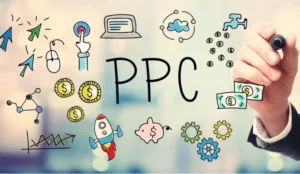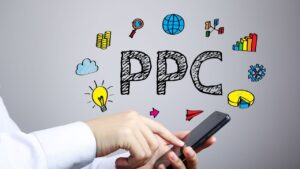Pay-Per-Click Marketing
A Complete Guide for Small Business Success
PPC marketing has become a vital strategy for businesses of all types to connect with their audience, grow traffic, and increase revenue. PPC is not just a marketing skill for small business owners, digital marketers, and entrepreneurs—it is a marketing strategy that produces visible results even with a limited budget.
This guide covers the basics and benefits of PPC advertising and how to get started if you’re curious about how it can enhance your marketing efforts.

What Is Pay-Per-Click Marketing?
PPC marketing is an online marketing model where companies pay a fee whenever their ad is clicked. In other words, it’s a method of purchasing traffic to your website instead of earning it through organic means. While quoting the specific keywords, advertisers bid, and for these keywords, ads are displayed in search engine results, websites, or social media based on relevance and bid.
Common examples of PPC platforms include Google Ads, Bing Ads, and social media channels like Facebook, Instagram, and LinkedIn.
With its inherent flexibility, control, and performance-tracking capabilities, PPC is an indispensable tool for small business owners. You set your budget, decide where your ads feature, and pay only when users interact with your ad, promoting transparency and cost-effectiveness.
Why PPC Marketing Matters for Small Businesses
Here are some reasons why PPC marketing should be a part of your digital marketing strategy: While PPC marketing has its shortcomings, it offers unique advantages for small businesses.
1. Immediate Results
While SEO takes time to generate traffic organically, PPC provides instant visibility. When your campaign goes live, your ads can instantly appear on search engine results pages (SERPs) or relevant websites.
2. Cost Control
PPC gives you complete control over your budget. You can define a daily or monthly budget, set your CPC limits, and suspend campaigns as necessary.
3. Targeted Reach
Also, with PPC, you can target the audience precisely based on location, demographics, interests, device type, and even behaviour. PPC helps you ensure that your ads get to the people who need them at the right time, whether you are appealing to local customers or broader audiences.
4. Measurable ROI
95% of PPC is quantifiable. You can monitor impressions, clicks, conversions, and costs, making it easy to compute ROI and evaluate which campaigns deliver the greatest results.
5. Flexibility and Scalability
So, whether you’re a solo entrepreneur or a mid-sized small business, PPC can grow with you. Begin with a small budget, learn and adapt, then scale to more lavish spending or more keywords when you are ready.

How to Create a Successful PPC Campaign
PPC success isn’t about throwing money at ads and hoping for the best. Head on to these steps for a smooth PPC campaign.
Step 1: Define Your Goals
First, determine what your goals for the campaign are. Would you like to visit your website and know how to bring traffic? Generate leads? Bring the focus to one specific product or service.
Well-defined goals will guide your ad copy, landing page design, and more. For example, a local bakery might want to promote catering for corporate events rather than just drive general visits.
Step 2: Select a Social Platform
One platform does one thing, and another platform does something else. Here’s a quick breakdown:
Google Ads is best for an intent-driven campaign in which you aim to target people who are already searching for your product/service.
For example, Facebook/Instagram Ads are well suited for visual storytelling and interest-based targeting.
LinkedIn Ads work best for professional or B2B services.
Choose a platform(s) relevant to your company/audience.
Step 3: Perform Keyword Research
Keywords are the backbone of PPC campaigns. You can use tools like Google Keyword Planner, SEMrush, or Ahrefs to find keywords related to your product.
214am Pro Tip: Targeting long-tail keywords is more efficient because they are lower-cost, lower competition, and highly targeted. So, instead of using a general keyword like “shoes”, search “affordable running shoes near me.”
Step 4: Write Attention-Grabbing Ad Text
3) Craft your ad copy. Users often see your ad copy before interacting with your business, so make it perfect. Follow these best practices:
- Emphasize unique offerings (for example, “Free shipping on all orders!”).
- Use a strong call-to-action (most popular are “Shop Now” and “Get a Free Quote!”.
- Write in simple human language.
Example:
Title: “Get A Quote For Affordable Pro Web Design – FREE Consult!”
You are an expert in your target audience. Description: “Get effective web design for low price. Call us today, and take the first step towards success.”
Step 5 The next step focuses on optimizing landing pages.
When someone clicks your ad, they should arrive on a page that closely matches your ad’s promise. Landing page design is a key element to conversions. Ensure your page:
- Loads quickly.
- Includes simple layout and appropriate content.
- Has a contact form or call-to-action button that is easy to find.
Step 6: Create a Budget That Fits Your Style
This is not an excuse to spend much more than you intended: PPC plays nicely at any budget level. Begin with a small amount, check on performance, and expand the spending of high performers accordingly.
Step 7: Measure and Refine
Always review campaign data and optimize. Focus on metrics like:
Click-Through Rate (CTR): The ratio of users who click on your ad.
Conversion rate: The rate at which users perform the action you want.
Cost-Per-Acquisition (CPA): The cost incurred to achieve a single conversion.
Pivot strategies as needed. If an ad group performs poorly, adjust it or redirect the budget to the best-performing ones.
Common Mistakes to Avoid in PPC Marketing
Avoid these common mistakes to get the most out of your PPC investment:
Failure to add negative keywords: By adding words that can attract unwanted people, you can help avoid wasting money on people who are not interested. For instance, no shoe stores should be paying for “free shoes” clicks.
Bad Ad Copy: Generic, non-specific ads will not lead to clicks. Don’t use generic language; tailor it to your audience.
Ignoring Mobile Users: Did you know that over 50% of web traffic comes from mobile users? Optimize your ads and landing pages for a great mobile experience. 58% of total website traffic comes from mobile.
Not Testing: A/B test headlines, visuals and landing pages to determine what works.
The Future of PPC
With the advancement of AI and automation, PPC marketing is also evolving. For example, tools like Google’s Smart Bidding leverage machine learning to boost the effectiveness of bidding strategies. Platform-specific ad formats—think TikTok—now offer smaller businesses the opportunity to reach younger audiences with new, innovative ad formats.
You can stay competitive in this ever-evolving space by keeping an eye on trends and being flexible.
Harness the Power of PPC Today
Pay-per-click marketing is one of the best methods small businesses and entrepreneurs can use to grow visibility, generate leads, and increase conversions. Now, spanning all of the steps and strategies covered in this guide, you’re set up to create PPC campaigns that provide accurate, measurable value to your business.
Whether you are a beginner or seeking specialized expertise, Schedule a consultation with [Your Company Name] today! We are a team of digital marketing specialists dedicated to helping businesses like yours succeed.
Begin your PPC success story now!”
Contact Us : Click Hear

